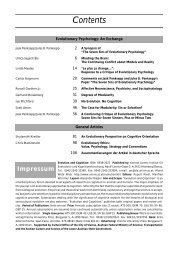Contents - Konrad Lorenz Institute
Contents - Konrad Lorenz Institute
Contents - Konrad Lorenz Institute
Create successful ePaper yourself
Turn your PDF publications into a flip-book with our unique Google optimized e-Paper software.
Was the First Craniate on the Road to Cognition<br />
Hence the need for the new discipline of evolutionary<br />
developmental biology” (p. 291).<br />
Harvard zoologist Stephen Jay GOULD, who died in<br />
2002, noted that DARWIN himself had not believed<br />
that natural selection was the exclusive means of<br />
evolutionary modification. Nevertheless, he said,<br />
certain “ultra-DARWINISTS” were trying to “out-DAR-<br />
WIN DARWIN” by claiming “that natural selection regulates<br />
everything of any importance in evolution”<br />
(GOULD 1997). For their part, neo-DARWINISTS accused<br />
GOULD of wandering too far from the<br />
reductionism 7 so necessary to science’s success.<br />
Daniel DENNETT even suggested that GOULD must<br />
have had a “hidden agenda” to sneak purpose back<br />
into biology (DENNETT 1996). The accusation was patently<br />
false; GOULD never wrote with any such intent;<br />
in fact, he went to great lengths to create new terms<br />
to replace any that smacked of teleology. “Preadaptations”<br />
became “exaptations” precisely to avoid the<br />
teleological overtones; “saltation” and “laws of<br />
form” became “facet-flipping” (GOULD 2002, pp342–<br />
351), helping to assure that the element of chance<br />
overshadowed any Platonic connotations.<br />
In his last monograph, GOULD wrote: “I argue<br />
that ‘internalism’ poses two separate challenges to<br />
pure DARWINIAN functionalism: saltational change<br />
arising from internal forces of mutability, and inherent<br />
directionality of variation… Most internalists …<br />
emphasize the second theme of channels and preferred<br />
directionality of variation” (2002, p445). One<br />
of the traits that made GOULD stand out from other<br />
internalists was his emphasis on chance. He seemed<br />
intent to exonerate himself from any charge of advocating<br />
teleology by assuring us that, though constraints<br />
have their important place, stochastic<br />
events have the final word. Our own existence is attributable<br />
to a “golden happenstance” in the Cambrian<br />
explosion (p. 1159), the start of an unlikely<br />
course that continued with the repeated overcoming<br />
of odds to produce humans as “an ultimate in<br />
oddball rarity” (1996–1997). If the developmental<br />
patterns of bilaterians appear to have become fixed<br />
into “limited and excellent, perhaps even optimal,<br />
designs”, it is only because they represent just one<br />
possible solution among numerous entirely plausible<br />
alternatives of strikingly different form, each<br />
yielding a subsequent history of life entirely different<br />
from the outcome actually experienced on<br />
earth” (2002, p1159). Yet all who support development’s<br />
importance to evolution (including GOULD,<br />
who used terms like “directionality” and “congealed<br />
designs”) must support the concept of directionality,<br />
however they explain it.<br />
ARTHUR uses the term “directionality” to describe<br />
the observation of large-scale evolutionary<br />
changes preceding smaller modifications, “big ‘experiments”<br />
giving way to progressively more restricted<br />
modifications” (ARTHUR 1997, p207), i.e.,<br />
the top-down concept that we will explore below.<br />
He writes: “This idea of directionality—which is<br />
absent from conventional neo-DARWINIAN theory—is<br />
important in Evolutionary Developmental<br />
Biology” (Ibid).<br />
Against this background, we can now return to<br />
the findings about the earliest known craniate, to<br />
note the support they yield for this article’s first two<br />
hypothetical options: human-level cognition as either<br />
fluke or common occurrence. We can also compare<br />
the support they afford straightforward neo-<br />
DARWINISM versus developmentalism.<br />
A listing of Haikouella-related supporting evidence<br />
for developmental constraints—and the<br />
ubiquity of human-level cognition in the universe—could<br />
read as follows:<br />
(1) early priority of cephalization over endoskeletization,<br />
(2) constraints/convergence/channeling, 8<br />
(3) hierarchical phylogenies,<br />
(4) saltation,<br />
(5) top-down pattern in the fossil record, and<br />
(6) the principle of mediocrity.<br />
Supporting arguments for contingency—and the<br />
rarity of human-level cognition in the universe—<br />
would include:<br />
(1) The appearance of craniates in the early Cambrian<br />
(the one period where the number of phyla<br />
decreases) greatly increases the probability that this<br />
lineage would become extinct;<br />
(2) Non-chordate phyla can be shown to be incapable<br />
of developing human-level cognition; and<br />
(3) Human-level cognition has evolved only once<br />
on this planet.<br />
As we recount the findings reported by Haikouella’s<br />
investigators, we will examine each of these<br />
in turn.<br />
Settling the Matter of Chordates<br />
in the Cambrian<br />
Before Jun-Yuan CHEN’s discovery of Haikouella<br />
(CHEN/HUANG/LI 1999a; CHEN/HUANG/LI 1999b)<br />
(Figures 1 and 2), it was beginning to look doubtful<br />
that Cambrian chordates would ever become firmly<br />
established. Each new interpretation of the mostly<br />
poorly preserved would-be-chordate specimens was<br />
hotly disputed.<br />
Evolution and Cognition ❘ 143 ❘ 2003, Vol. 9, No. 2








